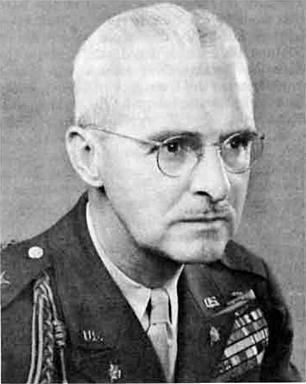

Charles Trueman Lanham
Commanding Officer 22nd Infantry
4th Infantry Division
July 9, 1944 - March 2, 1945
Charles T. Lanham was born in Washington, D.C. on September 14, 1902.
He entered the US Military
Academy on July 3, 1920 and graduated 73 out of 405 on June 12,
1924.
On that date he was commissioned a 2nd Lieutenant of Infantry.
While at the Academy his best subjects
were Economics Government & Political History and Law and his
worst subjects were Military Engineering
and Military Art.
|
|
Above: The entry for Charles T. Lanham in the U.S. Military Academy yearbook the Howitzer 1924
Lanham was promoted to 1st
Lieutenant on March 6, 1929.
He graduated from the Infantry School Company Officers Course in
1932.
On February 18, 1935 he was
assigned to the National Guard Bureau. He was promoted to Captain
on August 1, 1935. He was relieved of his assignment to the
National Guard Bureau on August 30, 1938.
He graduated from the Command
and General Staff School in 1939. Lanham was offered the
temporary
rank of Major (AUS) on January 31, 1941, which he accepted on
February 4, 1941. On June 12, 1941
he was promoted to Major in the Regular Army. He received a
promotion to the temporary rank of Colonel
(AUS) on January 6, 1943. On May 2, 1945 Lanham received a
promotion to the temporary rank of
Brigadier General (AUS). He was promoted to Lieutenant Colonel in
the Regular Army on June 12, 1947.
Lanham was appointed to the
temporary rank of Major General (AUS) On April 6, 1948. He was
promoted
to Colonel in the Regular Army on June 10, 1948 and Brigadier
General in the Regular Army on April 16, 1953.
Charles T. Lanham retired from the Army on December 31, 1954.
He received the Distinguished
Service Cross, the Silver Star Medal with Oak Leaf Cluster, the
Legion of Merit,
the Bronze Star Medal and the Purple Heart Medal.
The following is the citation for the Distinguished Service Cross to Charles T. Lanham:
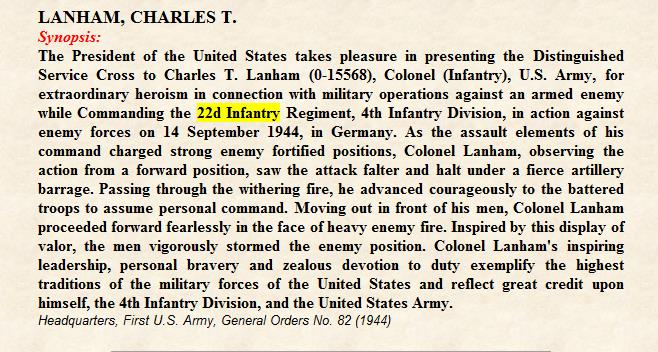
Lanham commanded the 272nd
Infantry Regiment of the 69th Division from early 1943 at
Fort Benning, Georgia. In June 1944 he left that organization and
was sent to Europe.
On July 9, 1944 he assumed command of the 22nd Infantry Regiment
and held that position
until March 2, 1945. He was assistant Division Commander of the
104th Division from March 5 to June 13, 1945.
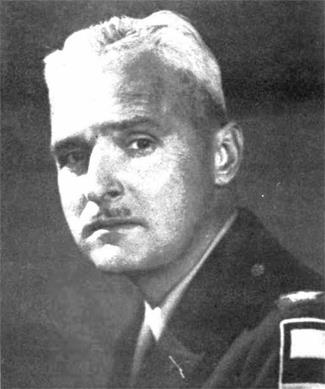
Colonel Charles T.
Lanham as Commander
of the 272nd Infantry Regiment 69th Division
Photo from HISTORY OF
THE TWENTY-SECOND UNITED STATES INFANTRY
in World War II
Compiled and edited by
Dr. William Boice
When Charles T. Lanham assumed
command of the 22nd Infantry Regiment the Regiment had already
been involved in fierce fighting in the attempt to break out from
the Normandy beachead. Colonel Hervey Tribolet,
the 22nd's Commander had been relieved of his command for not
achieving planned objectives and his
replacement, Colonel Robert Foster, was about to be relieved as
well. The following passage from Bill Boice's
History of the 22nd Infantry in WW2 illustrates Lanham's arrival
at the 22nd Infantry Headquarters:
" The
regiment was facing continued stiff resistance.
Once again, Division HQ was unhappy with the failure of the
regiment
to attain its objectives and to break the German resistance.
Accordingly, Colonel
Robert Foster was relieved of his command, and quite unknowingly,
the Double
Deucers were about to begin a shot-gun association with a
colorful figure who was
to change the destiny of a regiment.
A field phone rang. A Captain answered and heard, " I am
Colonel Charles
T. Lanham. I have just assumed command of this regiment, and I
want you to
know that if you ever yield one foot of ground without my direct
order I will courtmartial you. "
It was a proper introduction to 'Buck' Lanham. But the regiment
began
to fight with a skill, imagination and daring it would not have
attempted before. "
Lanham's command of the 22nd
Infantry elevated the Regiment into a fighting force to be
reckoned with.
He led the 22nd Infantry through the breakout from the Normandy
hedgerows, through the mad dash across France,
the first Allied penetration of the German Siegfried Line,
through the hell that was the Hurtgen Forest
and in the determination to "hold the line" during the
Battle of the Bulge.
After the battles in the Hurtgen Lanham sent this message to his 22nd Infantry Soldiers:
HEADQUARTERS
COMBAT TEAM 22
Command Post of the Combat Team Commander
Grand Duchy of Luxembourg
9 December 1944
TO THE OFFICERS AND MEN OF COMBAT TEAM 22
From 16 November
to 3 December 1944 you fought one of the greatest regimental
battles in military history.
By the end of the sixth day you had suffered approximately
50%casualties, the point at which a regiment is considered
to lose much of its effectiveness as a fighting instrument.
Actually you fought twelve (12) days beyond that point
with constantly increasing casualties and small loss in combat
efficiency.
From the night
of 16 November until our relief on 3 December our Combat Team was
the easternmost unit
in the entire army and therefore the greatest threat to the
German Reich. To stern our attack, units were withdrawn
as far south as the Schnee-Eiffel sector and as far north as
Merode and flung against us. Enemy forces opposing
American units on our right and left were repeatedly withdrawn
from those areas and committed against us.
Every enemy unit committed against us between 16 November and 3
December was destroyed.
During the last
days of this historic battle many platoons were commanded by
private soldiers who had joined us
only two or three days earlier. Few companies had more than one
officer and often these had just joined us.
The fact that Combat Team 22 took every objective assigned it
and, the day before its relief,
still had the tenacity, the will, and the fighting heart to
destroy a fresh enemy battalion, average age 24,
and in effectives equal to two of our battalions, is eloquent
testimony to the greatness of our Combat Team.
Our infantry,
our artillery, our engineers, our tanks, our tank destroyers, our
medical aid men, our collecting company,
combined in this operation to make the Battle of Hurtgen Forest
an eternal part of our country's history
and a military classic of all time.
We have finished
that battle. We have been moved to this sector to give us an
opportunity to reorganize, refit, and retrain.
How much time we shall have here no one knows but we do know that
in war, time always presses.
Therefore, in justice to our fallen comrades whose faith and
courage have carried us this far we must accomplish
our present mission with the same brilliance, tenacity, and
aggres siveness that characterized our great victory
in the bloody forest of Hurtgen,
There are no
words to describe my pride in you or my confidence in you. I can
only repeat what has been said to me
again and again by those who know your record and who have seen
you fight--"You are one of the greatest
fighting teams in all American history.
May God keep
your courage and faith high, and may He protect and
guard you in the hard battles still before us.
(signed)
C. T. LANHAM.
Colonel, 22nd Infantry J
Commanding.
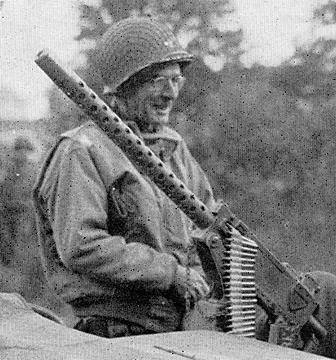
Colonel Charles T. Lanham September
1944
at the Siegfried Line
Photo from the 22nd Infantry Regiment yearbook 1946
Retired Colonel Earl W. Edwards
had become an officer in the 22nd Infantry in 1940. He served
under three
Regimental Commanders of the 22nd Infantry before Lanham assumed
command. Edwards as a Major led
2nd Battalion 22nd Infantry ashore on Utah Beach on D-Day. Four
days after Lanham assumed command
Edwards became S-3 Operations Officer for the 22nd Infantry. He
served in that capacity through the end
of the war. Edwards wrote the following memories of serving with
Lanham in a letter to author Edward Miller
when Miller was writing his book about the Hurtgen Forest battles
"A Dark and Bloody Ground" :
Soon after Col.
Lanham assumed command of the regiment, early in the war, I was
assigned as S-3- This brought me
into close and constant contact with him. In fact, I was seldom
more than a dozen yards out of his presence until he
was promoted and transferred out of the regiment. I guess I could
write a book about him but I'll try not to.
Colonel Lanham
was a most unusual individual. Our first few weeks together were
rough and involved-—quite a few clashes.
He and I could not have been more different and how we came to be
close friends will always remain a mystery to me.
Whatever he was, I could be described as at least different.
Colonel Lanham
could properly be described as brilliant. His intellect was first
rate. He was incisive in his analysis of any
given situation. His energy level was high and, being restless
and hard driving by nature, patience was not his long suit.
He was relentless and, at times, ruthless in his pressure for
results from his subordinates, excuses were not often received
kindly. He fully expected his battalion and company commanders to
lead their troops in battle rather than command
from a CP or foxhole.
Colonel Lanham's
education and experience in the military had given him the
knowledge and background to do his job.
He was well versed in infantry strategy and tactics as well as
the administrative end of the business. He was a hard worker
and gave more time and attention to seeing to it that every
possible detail that might contribute to success was taken care
of
than any other commander I ever worked for. If success was to be
had he meant to have it. Nothing was left to chance
if he could help it.
As a combat commander of our infantry regiment it is my belief that he was among the very best the army had to offer.
Now for a few traits on the down side.
His emotional
range was quite wide and volatile. He could change from being
exuberant and elated to being depressed
and angry in very short order depending on the circumstances of
the moment. His mood, particularly when he was exuberant,
led him to sometimes take leave of his usually sound judgment. It
was at these times that we sometimes clashed. He once told me
that he understood his tendency to get carried away and make
improper decisions and that he greatly appreciated it when I
called
his hand. Once when the regiment was ordered to cross a river and
attack some high, rocky cliffs that were heavily defended,
he deemed it to be a suicide mission and, in a depressed state,
he told me that he and I were going to get in a small rubber boat
and lead the regiment across and get killed. Several days later
when this particular exercise was canceled I was exuberant and
elated.
Colonel Lanham,
being a strongly opinionated man, had, over the years, developed
many strong likes and dislikes. One of these
was a great distaste for the cavalry which extended in spades to
the tank corps. He often contrasted their timidity in battle
sitting behind a thick slab of steel to the bravery of an
infantryman with only his bare chest facing the enemy. He could
be
hilarious when describing and acting out the bragadoccio of a
tanker starting out in a rear assembly area until they arrived
on the front line. This attitude was often reflected in his
relationship with the tank units which occasionally came under
his command. They did not have an easy time of it.
This same wide
range of feelings and attitudes extended to individual soldiers
and officers. He could, quickly, perhaps too quickly,
transit from admiration to disgust based on one or two
observations. Once he got down on any officer he could be
vindictive
and ruthless in his corrective action. On the other hand he could
be most loyal and supportive of both officers and men that
he respected and admired. And this carried over to individuals
long after the war.
Colonel Lanham
was ambitious, a trait not unusual in military officers. I cannot
say for sure, to what extent this figured in
some of his actions but certainly it played a part.
He also had a
strong tendency to come in conflict with higher commanders.
During my entire time with him he was
in full disagreement with virtually every decision our CG(General
Barton) made. At times he carried this to extremes,
in my opinion.
These traits of
his detracted from his overall performance to some degree but
nevertheless he was a highly successful
infantry commander. The record of the 22nd Infantry attests to
that.
He was a
difficult man to work for. His work and sleep habits were
erractic and mine were not. He could take out and get
30 minutes of sleep any time he wanted to and wake up refreshed
and ready to begin again. I could not.
He was a broadly
educated man, an excellent writer and conversationalist. He loved
to discourse on a wide range of subjects
anytime the situation permitted. This trait, as much as any,
probably led to his long association with Hemingway.
He had a highly
successful life in and after his army career. It was an
experience to be so closely associated with him.
I learned a lot.
When he was
assigned to head MAAG Belgium (I think) he stopped in Heidelberg,
Germany on the way and asked me
to go with him. I was unable to agree to this assignment for a
number of reasons but, due to the circumstances, I was unable
to clearly explain it to him. I was always sorry about that
because I think it hurt his feelings.
Letter from Earl W. Edwards courtesy of John and Gladys King
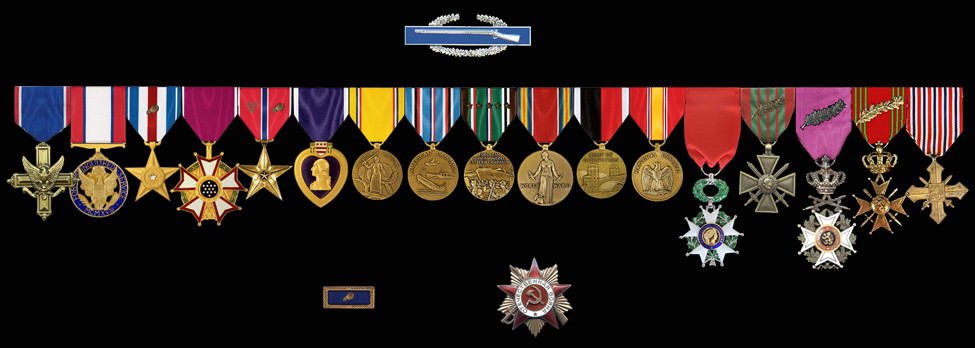
Charles T. Lanham's decorations
He was also awarded the Belgian Fourragere
***********************
The following excellent biography of
Charles T. Lanham was written by historian Charles Lewis
and is reprinted here with his permission:
Birth: Sep. 14, 1902
Washington
District of Columbia
District Of Columbia, USA
Death: Jul. 20, 1978
Chevy Chase
Montgomery County
Maryland, USA
Major General, U.S. Army
Charles Trueman Lanham was born to Ira Clifford and Alice Bryan
(O'Neil) Lanham on 14 September 1902 in Washington, DC.
He attended Eastern High School in Washington, DC.
Charles, known as "Buck," graduated from the U. S.
Military Academy on 12 June 1924, and was commissioned
as a Second Lieutenant in the Infantry branch of the U.S. Army.
His first assignment was with the 12th Infantry Regiment.
As a newly commissioned lieutenant, Lanham married Mary Gapen.
Buck and Mary had one daughter, Shirley,
and remained married until Mary's death in 1969.
On 6 March 1929, Buck was promoted to First Lieutenant. He
attended the Infantry School in September 1931 and upon
graduating,
remained as an Instructor. Other assignments included Company
Commander, 17th Infantry Regiment and, in February 1935,
assignment to the National Guard Bureau.
Lanham's recognized abilities as a military trainer and theorist
caused the Army brass to deny him field posts throughout the
1930s.
In his spare time during the 1930's, he wrote sonnets, a few of
which were published in Harper's Magazine, and some in pulp
fiction.
Buck was promoted to Captain on 1 August 1935. Later in 1935, he
was appointed Assistant Chief, Supply Division and
Associate Editor of the Infantry Journal. In September 1938, he
attended the Command and General Staff School, graduating in
1939.
He was later assigned as Company Commander of the 8th Infantry
Regiment.
For Buck, 1941 was a busy year. In January, he was assigned to
the Training Division Office, Chief of Infantry and on
31 January was promoted to Major. As World War II approached,
Buck directed preparation of Infantry training manuals,
then went to Hollywood where he wrote and supervised a widely
used series of Army training films. On 24 December 1941,
he was promoted to Lieutenant Colonel. In March 1942, Lanham was
made Chief, Visual Aids Branch, Army Ground Forces.
Buck was promoted to Colonel on 6 January 1943 and, in March, was
assigned as Regimental Commander
of the 272nd Infantry Regiment, 69th Infantry Division.
On 9 July 1944, he was assigned as Regimental Commander of the
22nd Infantry Regiment, 4th Infantry Division.
His unit, along with the 2nd Armored Division, spearheaded the
Normandy breakout and was the first unit into Paris.
Under Colonel Lanham's command, the 22nd Regiment participated in
the Battle of Hürtgen Forest. That was the name given
to the series of fierce battles fought between U.S. and German
forces during World War II in the Hürtgen Forest.
This became the longest battle on German ground during WWII, and
the longest single battle the U.S. Army has ever fought
in its history. The battles took place between 14 September 1944
and 10 February 1945, over an area of barely 50 miles,
east of the Belgian–German border.
Colonel Lanham's regiment attacked the Siegfried Line and on 11
September 1944, the first American Infantrymen into Germany
was a patrol from the 22nd Regiment. The 22nd Regiment sustained
eighty percent casualties in nearly three weeks of combat.
The unit was pulled off the frontline to be refitted and
supplemented with replacements, but was rushed back into combat
during the Battle of the Bulge, where the 22nd Regiment held a
key position. For its actions, the 22nd Regiment was awarded
two Presidential Unit Citations and Lanham received the
Distinguished Service Cross for his bravery under fire.
Lanham was awarded his first star as a Brigadier General in
February 1945 and on 3 March was made Assistant Division
Commander of the 104th Infantry Division, which attacked Cologne
and fought its way to a meeting with the Soviet Army
on the Molde River. After commanding occupying forces based in
Czechoslovakia and Austria, in November of 1945,
he was called to Washington, DC to become General Omar Bradley's
Chief of the War Department's Troop Information
and Education Staff. Here, he directed training and personnel
policies, first for the Army and then for the three services,
which were undergoing unification. Some of the training materials
came under criticism from right-wingers as being too liberal,
or not sufficiently anti-Communist. Buck retorted at one hearing
that they were opposed by both the Chicago Tribune -
and the Daily Worker. He said convictions were as important as
weapons, and that it was necessary to break down prejudices
among troops. However, this criticism did not adversely affect
his career and, in 1946, he was named Director of Staff
of the Personnel Policy Board under Secretary of Defense
Forrestal.
Brigadier General Lanham was transferred to the European Theater
in 1949, where he served Belgium and Luxembourg
as Chief of the Military Aid Group. In 1951, he became Chief
Press Spokesman for General of the Army Dwight D. Eisenhower
at Supreme Headquarters Allied Powers Europe (SHAPE), near Paris.
In that position, it was Buck that announced Eisenhower's
decision, in early 1952, to accept a draft for the Republican
Party's nomination to be the President of the United States.
After his promotion to Major General, Buck took command of the
1st Infantry Division in West Germany in January 1953.
In 1954, Gen. Lanham went to Norfolk, VA, on his final assignment
as Deputy Commandant of the Armed Forces Staff College.
During his military service, General Lanham's many awards
included the Distinguished Service Cross;
the Distinguished Service Medal (Army); and the Bronze Star
Medal.
Major General Lanham retired from active duty 31 December 1954.
A very interesting part of Buck Lanham's life began during WWII.
It was in 1944, during the Battle of the Hürtgen Forrest,
that Buck first met the famous novelist, Ernest Hemingway.
Hemingway was reporting on the war for Collier's,
an American magazine, and requested assignment with Lanham's 22nd
Infantry Regiment. They soon became close friends
and he ended up making Lanham's command post his base as a
reporter. Hemingway once described Colonel Lanham
as "The finest and bravest and most intelligent military
commander I have known."
Their friendship was so close that they maintained a steady
correspondence for seventeen years, ending only upon
Hemingway's death. While convalescing from his injuries, it is
said that the novelist wrote to the soldier as he would
to a father confessor. It is also widely reported that he built
his portrayal of Colonel Cantwell, protagonist of
"Across the River and Into the Trees," on the life of
Lanham.
After his 31 December 1954 retirement and beginning with Market
Relations Network, Lanham began a second career
as a public relations executive for a number of companies. Time
magazine, in its 28 November 1955 issue in the
"PERSONNEL: Changes of the Week" column, reported:
"Major General Charles Trueman Lanham (ret.), 53, Dwight
Eisenhower's chief press officer in SHAPE (and
"prototype"
of Colonel Cantwell, hero of Hemingway's Across the River and
Into the Trees), is slated to be board chairman of
Colt's Manufacturing Co., which was taken over last week by
Penn-Texas Corp. (TIME, Oct. 3). Born in Washington, D.C.,
West Pointer "Buck" Lanham wrote poetry until it
interfered with his Army career, later edited Infantry in Battle,
a widely used
Army textbook. In World War II, he fought through Normandy and
the Bulge with the 22nd Infantry Regiment,
earned a jacketful of decorations, including the Distinguished
Service Cross."
The Penn-Texas Corporation's subsidiaries included Colt's Patent
Firearms. The conglomerate went through a rapid expansion
under the guidance of the Silberstein family, with who Lanham was
closely aligned. The company's attempt to acquire Fairbanks,
Morse and Company through a proxy and hostile takeover resulted
in a public and acrimonious legal battle. Lanham resigned
in 1958 following a disagreement with the Silberstein's over the
direction of the company.
Lanham attempted to start his own company,
Lanham-Patterson-Wilson, Inc., before joining Xerox in 1960 as
Vice President for Government Relations. He retired from Xerox at
the end of 1970 and spent his remaining years
in Chevy Chase, MD, with his second wife, Jane Gay.
Major General Charles Trueman "Buck" Lanham died from
cancer 20 July 1978 in Chevy Chase, MD, at the age of 75.
He was preceded in death by his wife, Mary Gapen Lanham, on 27
April 1969. On their headstone, above Mary's name,
are these words: "His Wife and Fellow Soldier."
Bio compiled by Charles
A. Lewis
from the Find A Grave memorial
**********************
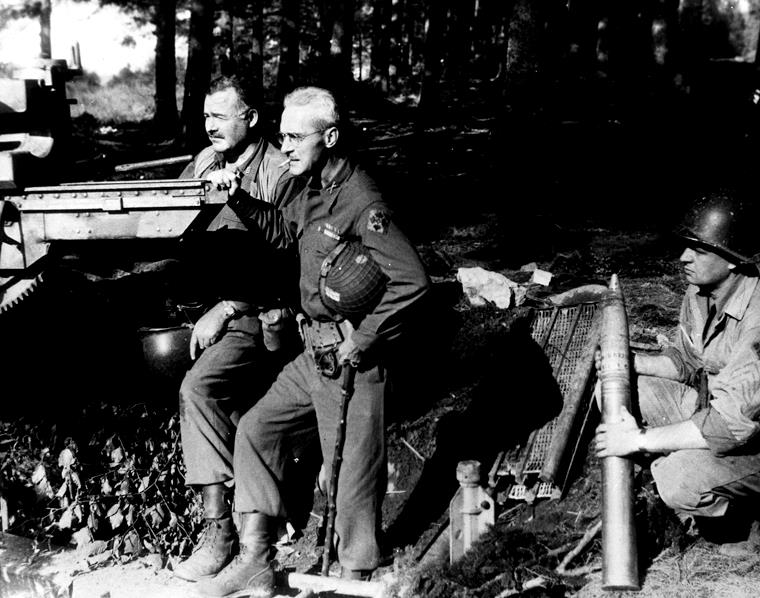
Ernest Hemingway and
Colonel Charles T. "Buck" Lanham with captured
artillery in Schweiler, Germany, 18 September 1944.
(Ed., Captured gun is German 88mm; note SGT at far right holding
88mm artillery round.
Also note that Lanham is wearing his 4th Division SSI
incorrectly. The point of the Ivy Leaves
should be in line with the center of his shoulder. Instead they
are incorrectly turned 45 degrees.)
Photograph in the Ernest Hemingway Photograph Collection, John F. Kennedy Presidential Library and Museum, Boston.
|
Left: This sketch of The artist has replaced the In that insignia at the very The illustration is from the |
"It was the heroic charge
of an infantry regiment led by Col Lanham that first penetrated
the Siegfried Line in force
to bring the might of the American foot soldier against the Nazi
hordes on the "sacred" soil of the Reich.
Shouting and singing at the top of his lungs and calling out to
his men by name, the tall, slim colonel, through the sheer
magnetism
of his personality and courage, rallied his men from impending
retreat and, under withering fire, sent them storming
through enemy fortifications.
Their objective was gained with
the 1st Army firmly entrenched on German soil. The spirited dash
came when
Col. Lanham left his command post after given field telephone
reports as "Pinned down by heavy fire" "Tank
destroyers
unable to make progress," and "The men are falling
back" and stormed to the forward line where his men, without
tank support
and armed only with rifles, were fighting atop enemy
fortifications, while the Germans inside poured machine-gun fire
into their lines.
The breach of the Siegfried Line
is not the only story told of the Colonel's valor. There was the
time his regiment attacked
camouflaged pillboxes on the top of a hill. Pinned down under
heavy fire with retreat cut off, the regiment was again saved
by the colonel's quick-thinking action. Discarding his trench
coat, which he never expected to use again, he signaled to
his only tank destroyer to advance and directed the fire which
destroyed the pillboxes one by one. A native Washingtonian,
Col. Lanham, whose father is Clifford H. Lanham, District
superintendent of trees and parks, wears the Silver Star, the
Bronze Star
and the Purple Heart. In addition, his regiment part of the 4th
Division, the first to enter Paris, was twice decorated with the
Presidential Unit Citation. Colonel of the Washington High School
Cadets when he was attending Eastern High School in 1920,
Col Lanham was graduated from West Point in 1924. His wife, the
former Mary Gapen,
lives at 104 North Columbus Street, Arlington, Va."
Article and photo from the D.C. Star, November 1944
via Karen Scott
**********************
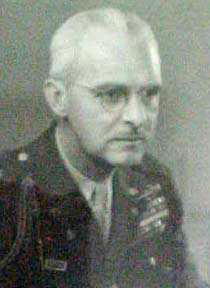
Colonel Charles T. Lanham
This portrait of Colonel Lanham hung on
the wall at 1st Battalion 22nd Infantry Headquarters
at Fort Hood, Texas, 1999-2009. Photo courtesy of Major Anne
LeGare, wife of LTC Marc LeGare,
Commanding Officer 1-22 IN 1999-2001.
"Say only this of me when I
am Dead
'He saw proud eagles storming down the sky
He heard the braken brake where beauty fled
And, wingless, strove to fly.'"
From a contemporary news report:
"The officer whom Ernest Hemingway called "the finest
and bravest and most intelligent regimental comander I have ever
known"
died of cancer at home in Chevy Chase, Maryland, at July 20, 1978
at the age of 76.
"As a Colonel, he led the 22nd Regiment, 4th Infantry
Division, which spearheaded the Normandy breakout, entered Paris,
attacked the Siegfried Line and held a key salient in the Battle
of the Bulge. The Regiment won two Unit Citations
and he ultimately won 17 decorations. During the Battle of the
Hurtgen Forrest, Hemingway made his base as a reporter
in Lanham's command post. They became close friends and kept up a
steady correspondence for seventeen years.
Convalescing from injuries, the novelist wrote to the soldier as
to a father confessor. It is said that he built his portrayal
of Colonel Cantwell, protagonist of "Acros the River and
Into the Trees," on Lanham.
"He was himself an amateur poet and writer as well as a
combat infantryman. Also was a leading military instructor,
something of a diplomat and, after retirement from the service,
an industrial executive. He was born in Washington, D.C.
September 14, 1902, and graduated from West Point in 1924, from
the Infantry School in 1932 and the Command and
General Staff School in 1939. In the 1930s, he helped to edit the
Infantry Journal and, in his spare time, wrote sonnets,
a few of which were published in Harper's Magazine, and some pulp
fiction. As World War II approached, he directed
preparation of Infantry training manuals, then went to Hollywood
where he wrote and supervised
a widely used series of training films.
"In Normandy in June 1944, he took command of the 22nd
Regiment and led it in the breakout from the beaches.
It was one of the first U.S. units to reach Paris, then the first
to reach Germany and to penetrate the Siegfried Line.
There, in the Hurtgen Forrest, the regiment suffered 80-percent
casualties in eighteen days. Brought back to Luxembourg
to reorganize and rest, it was soon caught up in the Battle of
the Bulge. Some of its units were cut off, but it held.
He was promoted to Brigadier General that February and made
Assistant Commander of the 104th Division, which attacked
Cologne and fought its way to a meeting with the Soviet Army on
the Molde River. After commanding occupying forces
based in Czecholovakia and Austria, he was called to Washington,
D.C. to direct training and personnel policies, first for
the Army and then for the three services, undergoing unification.
Some training materials came under criticism from
right-wingers as too liberal or not sufficiently anti-Communist.
He retorted at one hearing that they were opposed by the
Chicago Tribune and the Daily Worker. He said convictions were as
important as weapons, and that it was necessary
to break down prejudices among troops.
"Transferred to the European Theater in 1949, he helped to
organize the forces of Belgium and Luxembourg, then became
Chief Press Spokesman for General Dwight D. Eisenhower at the
Allied Headquarters near Paris. It fell to him to announce
the commander's decision in early 1952 to accept a draft for the
Republican Presidental nomination. He then took command
of the 1st Infantry Division in West Germany in January 1953. He
returned the next year as Deputy Commandant
of the Armed Forces Staff College at Norfolk, and retired at the
end of 1954, as a Major General, to join the
Pennsylvania-Texas Corporation of Colt's Patent Firearms. He
resigned in 1958 and joined Xerox in 1960 as
Vice President for Government Relations, retiring from that post
at the end of 1970."
He is buried in Section 4 of Arlington National Cemetery.
From the Arlington Cemetery website
The above article from the |
|
The following obituary was posted in The Washington Post
Maj. Gen. Charles Lanham Dies
By Jean R. Hailey July 22, 1978
Retired major general Charles Trueman (Buck) Lanham, 75 a
fighting hero of World War II who also was an
information and education specialist during a long, distinguished
Army career, died of cancer Thursday at his
home in Chevy Chase.
He led an infantry regiment that spear-headed the breakout from
Normandy after the landing there in 1944 and
then went on to become the first American unit to enter Paris.
Gen. Lanham returned to that capital city later to serve as
director of public relations at SHAPE during Gen.
Dwight D. Eisenhower's two years as commander of NATO forces
there.
While on the battlefield, Gen. Lanham, by then a published author
and poet as well as a scholar, met another
writer, Ernest Hemingway, who was reporting on the war and had
attached himself to Lanham's regiment. A
lasting friendship developed and they corresponded frequently
until Hemingway's death in 1961.
Gen. Lanham was born in Washington. He graduated from the U.S.
Millitary Academy at West Point in 1924. As an
infantry officer, he commanded various units and graduated from a
number of Army schools.
He also began to teach and to write. He was an instructor in
millitary history at Ford Benning, Ga., and
later an associate editor of the Infantry Journal while on
assignment with the National Guard Bureau in
Washington.
As a writer, Gen Lanham was better known within the Army than
without. In the years immediately prior to
World War II, he wrote the tactical doctrine for the infantry
used during the war and "ghosted" a military
textbooks, "Infantry in Battle" for Gen. George C.
Marshall, U.S. Army chief of staff.
As chief of the visual aids branch of Army Ground Forces in 1942,
Gen. Lanham developed new visual
educational techniques for the Armed Forces. He wrote and
directed training films, including the famous
"Fighting Men" series.
Most of all, he was a fighting man. His battles included those he
fought to get assigned to combat areas. He
finally made it to the European Theater of Operations where he
took command of the 22nd Regiment of the 4th
Infantry Division in Normandy in June 1944.
That regiment helped lead the move out of Normandy and was the
first American unit to go into Paris in August
1944. It also put the first patrols on German soil and was the
first to penetrate the Siegfried line in the
battle of Huertgen Forest.
During 18 days and nights of steady combat, the regiment suffered
more than 80 per cent casualties but it was
the first American unit to reach the Cologne Plain. The 22nd
Regiment then was assigned to quiet sector in
Luxembourg to rest but almost immediately found itself involved
in the Battle of the Bulge, Gen Lanham
recorded later.
This was in December 1944 when he held the rank of colonel.
Several months later, he was promoted to general
officer rank on the battlefield and assigned as assistant
division commander of the 104th (Timberwolf)
Infantry Division, which attacking the city of Cologne.
In September 1945 Gen. Lanham was recalled to Washington by Gen.
Marshall to serve as chief of the troop
information and education department of the War Department. It
was his job to make GIs, particularly those
overseas, the "best informed soldiers in the world".
Three years later he became head of the Army's Personnel Policy
Board. A special project of Chief of Staff
Gen. Omar N. Bradley, it became better known as the "human
relations" board. Its purpose was to present a
better image of the Army to the public in an effort to get better
public support.
Its work was so successful that it was raised to the Defense
Department level to establish fundamental policy
for all millitary and civilian personnel of the Army, Novy, Air
Force, Marine Corps and Coast Guard.
Gen. Lanham returned to Europe in 1949, serving first in
Heidelberg, Germany, and then in Brussels, where he
was chief of the Millitary Advisory Group for Belgium and
Luxembourg.
He was picked by Gen. Eisenhower to be the first public relations
director for Supreme Headquarters Allied
Powers in Europe, known as SHAPE. One of his duties was to
arrange for press conferences for Gen. Eisenhower,
who was besieged by newspaper, magazine and wire service
correspondents from around the world.
Gen. Lanham, who was at ease in French as well as English,
reportedly handled the press representatives with
tact and aplomb. He also reportedly often filled them with
martinis.
In January 1953 Gen. Lanham was reassigned to Germany to take
command of the famous 1st Infantry Division. He
remained there for a year and a half. His last assignment before
retiring at the end of 1954 was deputy
commandant, Army, of the Armed Forces Staff College in Norfolk,
Va.
The numerous decorations he had received during his military
service included the Distinguished Service
Award, the Silver Star with Oak Leaf Cluster, the Legion of
Merit, the Bronze Star with Oak Leaf Cluster, the
French Legion of Honor. The French Croix de Guerre and the
Belgian Croix de Guerre.
While he often talked descriptively of hism any millitary
esperiences, Gen. Lanham loved to tell stories
about his relationship with Hemingway.
He recalled that Hemingway was a war correspondent for the old
Collier's magazine and joined the 4th Infantry
Division on the third day of the Normandy breakthough. Hemingway
attached himself to Lanham's 22nd regiment
and stuck with it through the Battle of the Bugle. The two kept
in touch over the years and miles by letters.
"We wrote freely because we could trust each other. Old
Hemingstein (Gen. Lanham's name for Hemingway)
couldn't say 'hello' to anyone without someone going out and
writing an article about him. He knew I
wouldn't," Gen. Lanham once explained.
The correspondence between the two was called the 'longest',
fullest and most informative sequence of
Hemingway's letters to come to light," by Carlos Baker, a
Princeton University professor, who is Hemingway's
authorized biographer.
Gen. Lanham had collaborated with Baker, author of "Ernest
Hemingway - A Life Story," and also had presented
nearly 150 letters he had received from Hemingway to the
Princeton University Library.
Although Hemingway had insisted that he did not want to be the
subject of a biography, Gen. Lanham said once
that he wasn't worried about aiding Baker.
"I know goddam well what he (Hemingway) wanted," he
said. "He wouldn't have liked the Baker book, though,
because it's got all the warts in it."
Gen. Lanham also said he was told by Mary Hemingway, the author's
widow, that on the afternoon before her
husband shot himself to death in July,1961 he read the last
letter he had received from his friend, Gen.
Lanham.
The general frequently had been approached by publishes to write
a book about some of the famous persons he
had known - Eisenhower, Bradley, Marshall, Truman, Hemingway. He
turned them down.
"I made it perfectly clear," he once said, "that I
would never betray a confidential relationship."
In his poetry, Gen. Lanham death with many subjects, including
the military. He wrote a five-stanza "Pocket
Poems for A Soldier" and another he called "West
Point." His poetry included Epitaph," in which he
wrote:
"Say only this of me when I
am dead:
'He saw proud eagles storming down the sky;
'He heard the bracken break where beauty fled;
'and, wingless, strove to fly.'"
After he retired from military service, Gen. Lanham became vice
president for government relations of the
Xerox Corp. He retired for a second time in 1970 but remained
with the firm as consultant until 1972.
He is survived by his wife, Jane Gay Lanham, of the home, and a
daughter, Shirley L. McCrary, of Birmingham, Ala.
The family suggests that expressions of sympathy be in the formof
contributions to the Fellowship Assistance
Fund of Army Distaff Hall or the American Cancer Society.
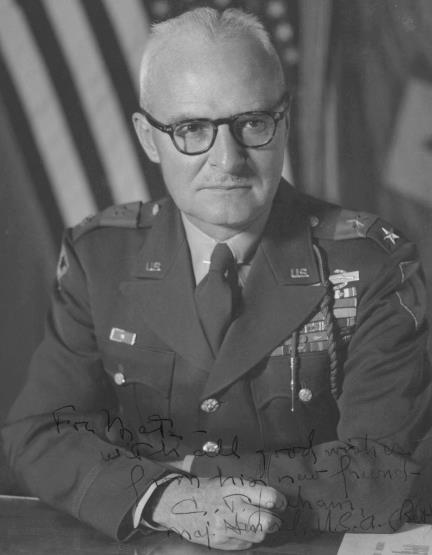
Charles T. Lanham as a Major General
Photo by Mats Edholm
Arlington
Cemetery website
The following is the obituary of
Charles Lanham recorded in the June 1979 issue of Assembly,
published by the USMA Association of Graduates:
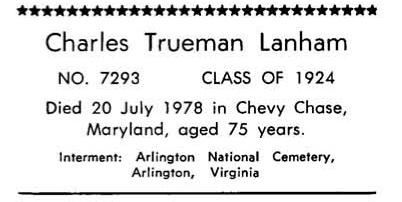
AFTER BATTLING CANCER for many
years, Buck Lanham joined the Long Gray Line on 20 July 1978.
His loss has brought sadness to his devoted family and a sense of
great personal loss to his many friends and associates —
especially his classmates.
During our plebe summer of 1920,
the six hundred and forty new cadets were organized into six
companies.
Since the two upper classes were away from West Point, our
"beast detail" was composed essentially of tactical
officers,
reinforced with the few turnbacks acting as cadet officers. It
was a busy period, devoted primarily to drill and physical
development and later to field training and long hikes. As the
summer wore on and we became inured to cadet life,
our span of acquaintances broadened. We found among our fellows
all degrees of age and experience; some were veterans
of the recent World War, a few were collegians with athletic
prowess, but most were fresh from high schools with little
or no military experience or background. Thus it happened that
one among us acquired glamour and commanded respect
when we found that he was no ordinary person, but an ex-colonel
of high school cadets in our National Capital!
Impressive as this may have been to his peers, when the yearlings
returned from their summer at Fort Dix,
Mister Lanham quickly became "Buck" rather than
ex-colonel.
Long before graduation Buck's
profile began to form, not as a star athlete or even a wearer of
academic stars, though
he was always a good student, but as an imaginative, sensitive
and creative man endowed with a remarkable gift of expression
in both poetry and prose. He was very properly selected as the
first literary editor of the Pointer and also as a member of the
HOWITZER Board. A frequent contributor to various magazines, he
probably was best known for the works which
expressed his love for the military profession. An outstanding
example is his poem about West Point which was published
during his First Class year.
VALE
I
Oh Spartan Woman, I have peered
behind
Your stoic pose and found the mother there
At last: the proud gray eyes, the cool gray hair,
The tender face a hundred years have lined
With sorrow for the still,
straight sons returned
Upon their blameless shields; the quiet pride
That they have lived by you, went forth, and died
The Dorian way. Gray Mother they have earned
Those shields.
Thus have they justified the
trust
You placed in them and come again to live
And breathe as part of you. Today you give
A burnished shield to me, to guard from rust,
To hold before my heart; and bid
me go.
Stern Spartan, I salute you—but I know!
VALE
II
I shall remember you until the
end
As I best loved you—sheathed and still between
Your quiet hills—a sleeping blade of keen
Damascus steel stained silver by a bend
Of moon, for I could understand
you best
At night when we were both a little tired
Of pomp and play. How often then you fired
A dream and sent it off on some strange quest
That Lancelot would pawn his
heart to know!
How often then you spun your subtle mesh
Of time about me—calling souls from flesh
Forgotten all these hundred years ago!
And so I shall remember you at
last
As I best loved you—sleeping in the past.
Upon graduation Buck chose the
Infantry. The foot soldier was his ideal; he dramatized the smoke
of battle and the
hardships of campaign. Years later Buck expressed his consuming
admiration of the doughboy in a widely published poem
entitled simply, "Soldier."
Shortly after graduation Buck
married Mary Capan—and like Buck she was a native of
Washington. His early years
as an infantry officer followed the pattern of his era: two to
three years at a domestic post, a foreign service tour,
then on to branch school. But then the pattern changed from the
norm. After graduation from The Infantry School at
Fort Benning he was assigned to the faculty as an instructor of
military history. Soon he became a contributor to the
Infantry Journal and a protege of its editor, Forest Harding. His
writings came to the attention of such distinguished
military leaders as George C. Marshall, Omar N. Bradley and
Clarence R. Huebner, who saw in them a keen perception
of military tactics, strategy and organization.
Thus it was that when war clouds
began to gather in the mid-thirties and a hue and cry arose for
changes
in our military doctrine, training, organization and equipment,
the talent and imagination of officers like Captain Lanham
came into great demand. It resulted in keeping Buck on staff
assignments during the early war years at a desk in
Washington, where he was considered too valuable for release to
troops. It was a frustrating period for Buck,
but in January 1943 he was able to break away and take command of
the 272d Infantry of the 69th Infantry Division,
which was then undergoing organization and training. Now, at
last, he was doing what he wanted and he looked forward
to taking his organization into action, meanwhile training it to
the height of efficiency. That was not to be, however, for in
June,
just six months later, he was flown to Normandy to command the
22d Infantry Regiment of the 4th Infantry Division
already in combat. This was the goal he had sought—the
fulfillment of his dreams.
Witness the picture of a
forty-year old colonel who wrote poetry during his cadet days at
West Point and later excelled
as a military writer, who for the past ten years had been denied
duty with troops because of his ability as an instructor
of military art, expressor of needs and originator of doctrine,
now suddenly projected into the cauldron of battle.
The challenge was supreme, but it was what he had long sought and
he met it successfully. Joining his regiment on the
Normandy beachhead, he led it to a breakthrough of the enemy
lines.
The third day thereafter, a war
correspondent of Collier's magazine was attached to the regiment.
It was Ernest Hemingway,
already a famous author. Immediately he and Buck became close
friends. Their mutual love of words as the building blocks
of expression drew together the professional soldier and the
professional writer, and the friendship thus began continued
until Hemingway's death in 1961.
In combination with Combat
Command "A" of the 2d Armored Division, the 22d
Infantry spearheaded the breakout
of Normandy and was the first American unit to enter Paris. Later
it was the first to put patrols on German soil
and the first to penetrate the Siegfried Line. During eighteen
days and nights in the Huertgen Forest it sustained
80% casualties; but before it could be rested, re-equipped and
restored by replacements, it was rushed into the
Battle of the Bulge. When the 4th Infantry Division resumed the
counter-offensive, the 22d Infantry again
penetrated the Siegfried Line.
During its months of combat, the
regiment was awarded two distinguished unit citations; and its
commander was awarded
the Distinguished Service Cross, the Silver Star Citation, the
Legion of Merit, the Bronze Star with "V" and Oak Leaf
Cluster,
and the Combat Infantry Badge. Foreign awards included the French
Legion of Honor; the French Croix de Guerre with palm;
the Belgian Order of Leopold in the degree of Officer; the
Belgian Croix de Guerre with palm; and the Belgian Fourragere.
Not bad for a colonel who had been considered a theorist in the
art of war and a dreamer rather than a doer, but one
whom General Hodges, the First Army commander, called the finest
regimental commander he had seen in two wars.
In February 1945, Buck was
promoted on the battlefield to brigadier general and assigned to
the 104th Infantry Division
as assistant division commander. He fought with this Division
until contact with the Russians on the Mulde River in April.
Two months later he was assigned to command the 26th Infantry
Division with station at Linz, Austria, but the war
was now over and in September he was ordered back to Washington
to be Chief of the War Department's Troop
Information and Education Division. Later in the year the Chief
of Staff (General Bradley) selected him as his first assistant
for human relations. The following year, 1946, Secretary of
Defense Forrestal called General Lanham to his office as
"Director of Staff of the Personnel Policy Board."
After four years in Washington,
Buck was called back to Europe for duty on the staff of the
Commander-in-Chief
European Command and early in 1950 he became chief of the
military aid group for Belgium and Luxembourg.
The following year he was ordered to Supreme Headquarters Allied
Powers Europe in Paris as chief of public relations
for Supreme Allied Commander, Europe. This was a happy time for
Buck and his wife Mary for they had lived in Paris
many years before, when Buck was a student of the French language
in preparation for a teaching assignment at West Point.
After promotion to major general
rank in 1953, Buck commanded the 1st Infantry Division in Germany
and then returned
a year later to continental duty as deputy commander of the Armed
Forces Staff College. Following his retirement in 1954
he accepted a position with Penn Texas Corporation, then in 1960
he was tapped to be the Xerox Corporation vice president
for government relations. Early in his post-military career, he
built a fine home in Chevy Chase, Maryland, where he could
entertain his many friends and enjoy suburban living. In pleasant
surroundings he worked his garden and improved the
landscape as all his life he had worked to improve the world he
lived in.
After Mary's death in 1969 Buck
pursued his activities with head high as he had lived his life.
He later married Jane Gay
and their partnership brightened the home they lived in. Even
after cancer struck, Buck found comfort in his surroundings
and strength to fight the final battle—a battle he could not
win because of the odds against him.
Among his poems is one called "Epitaph" in which he said—
Say only this of me when I am dead:
"He saw proud eagles
storming down the sky;
He heard the bracken break where
beauty fled And wingless, strove to fly."
It is indeed a fitting epitaph for Charles Trueman Lanham, whose remarkable military career will long be remembered.
-C.D.E., J.E.M., and H.D.V.
**********************
|
Portrait of Charles T. Lanham
Seeley G. Mudd Manuscript Library 65 Olden Street Princeton, New Jersey 08540 USA Phone: 609-258-6345 Fax: 609-258-3385 mudd@princeton.edu http://www.princeton.edu/~mudd |
Princeton University Library
holds the collection of the Charles T. Lanham Papers 1916-1978.
The Charles T. Lanham Papers document the general's WWII and post
war military service and his private sector employment
with several corporations. The papers contain correspondence,
scrapbooks, photographs, journals, speeches,
and legal documents. This collection is stored onsite at the Mudd
Manuscript Library. Finding Aids for the Papers
can be found at the following link:
**********************
Charles Trueman
Lanham is buried at Arlington National Cemetery
in Section 4 Grave 20
He was interred on July 24, 1978
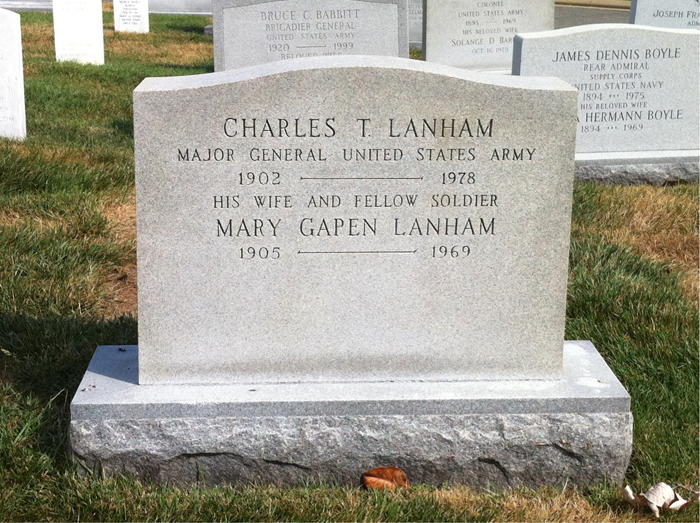
The grave of Charles T. Lanham
from the Official Website of Arlington National Cemetery
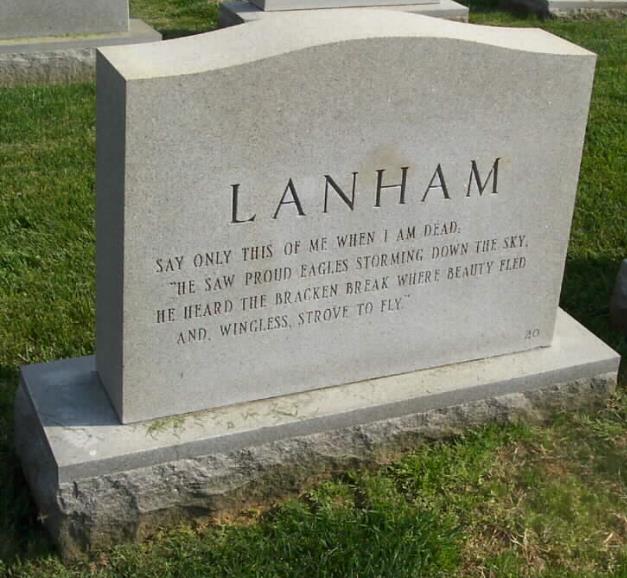
Reverse side of the marker for Charles T. Lanham
Photo By M. R. Patterson, 23
April 2004
Arlington Cemetery website
**********************
Soldier
The stars
wing down the western steep,
And soon the east will burn with day,
And we shall struggle up from sleep
And sling our packs and march away.
In this brief hour
before the dawn
Has struck our bivouac with flame
I think of men whose brows have borne
The iron wreath of deadly fame.
I see the fatal phalanx creep,
Like death across the world and back,
With eyes that only strive to keep
Bucephalus' immortal track.
I see the legion wheel through Gaul,
The sword and flame on hearth and home,
And all the men who had to fall
That Caesar might be first in Rome.
I see the horde of Genghis Khan
Spread outward like the dawn of day
To trample golden Khorassan
And thunder over fair Cathay.
I see the grizzled
grenadier,
The dark dragoon, the gay hussar,
Whose shoulders bore for many a year
Their little emperor's blazing star.
I see these things, still am I slave
When banners flaunt and bugles blow,
Content to fill a soldier's grave
For reasons I shall never know.
written by Charles T. Lanham
Home | Photos | Battles & History | Current |
Rosters & Reports | Medal of Honor | Killed
in Action |
Personnel Locator | Commanders | Station
List | Campaigns |
Honors | Insignia & Memorabilia | 4-42
Artillery | Taps |
What's New | Editorial | Links |